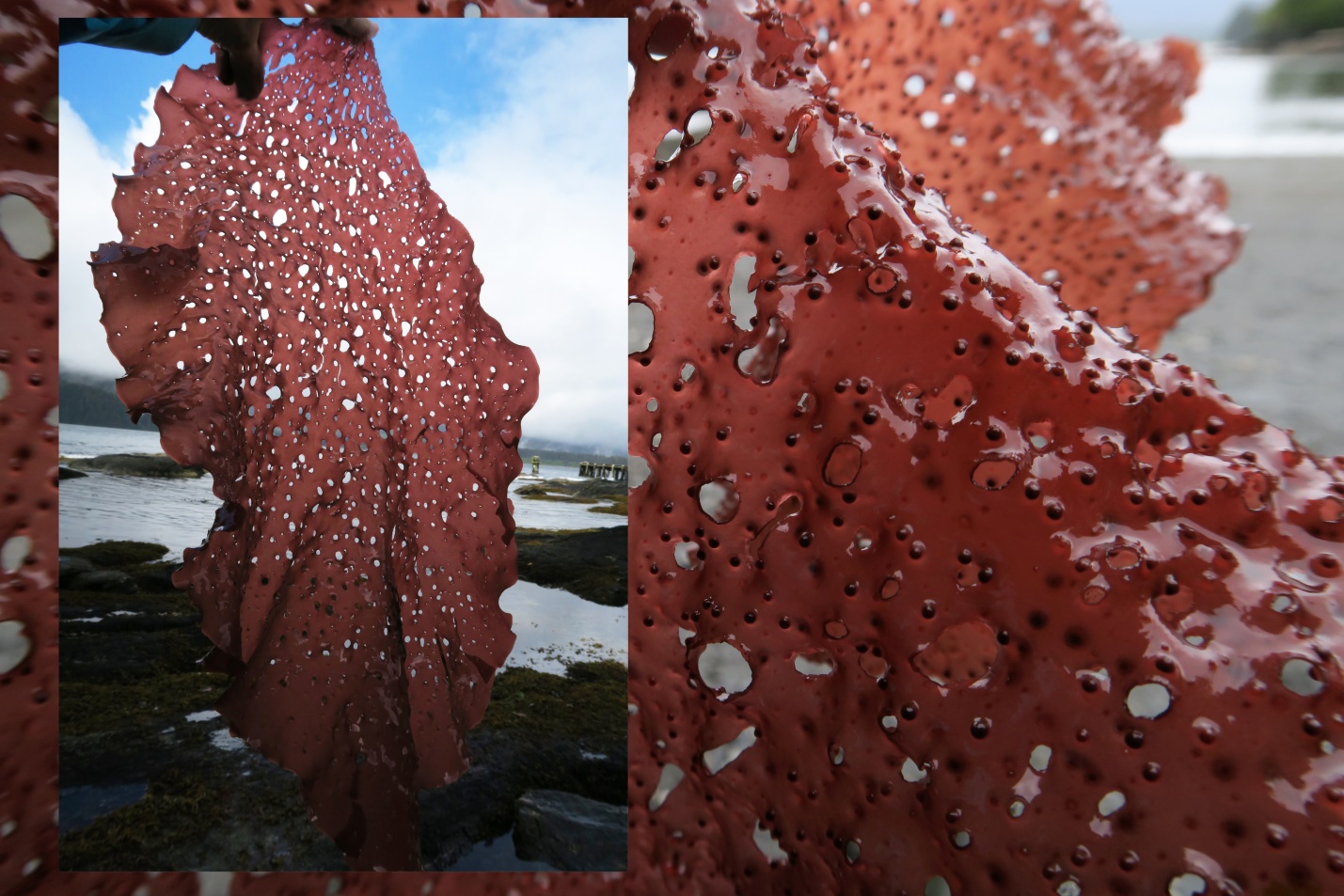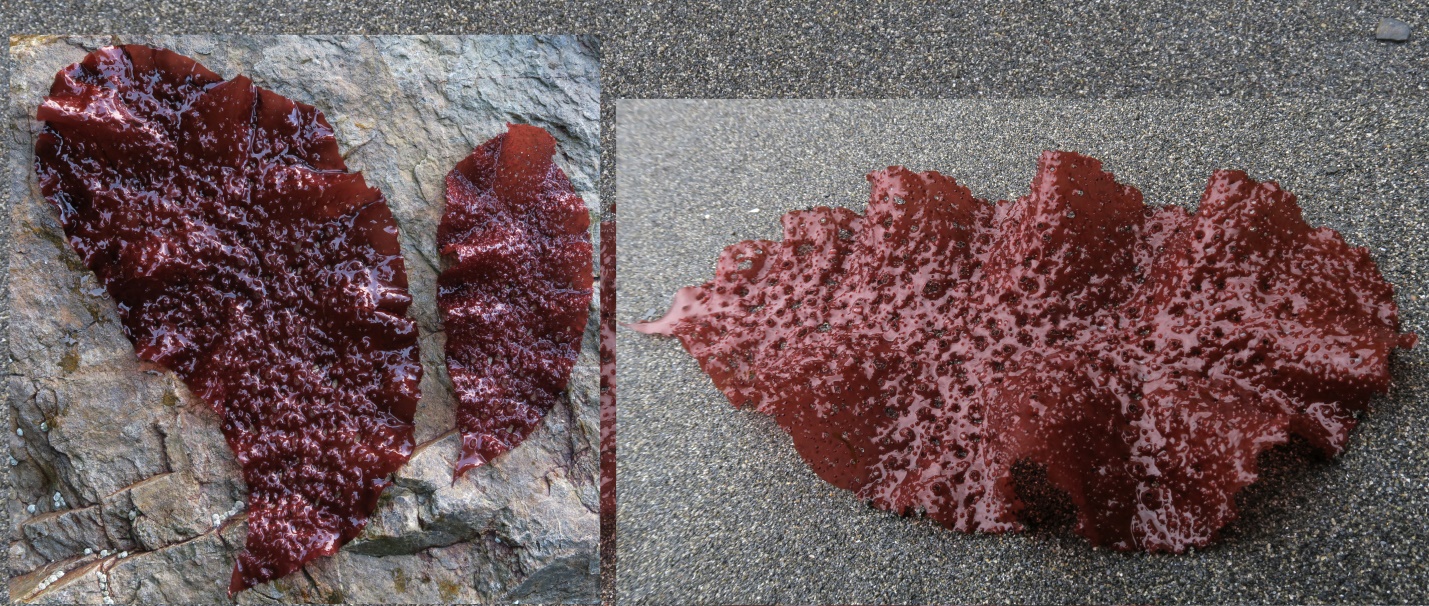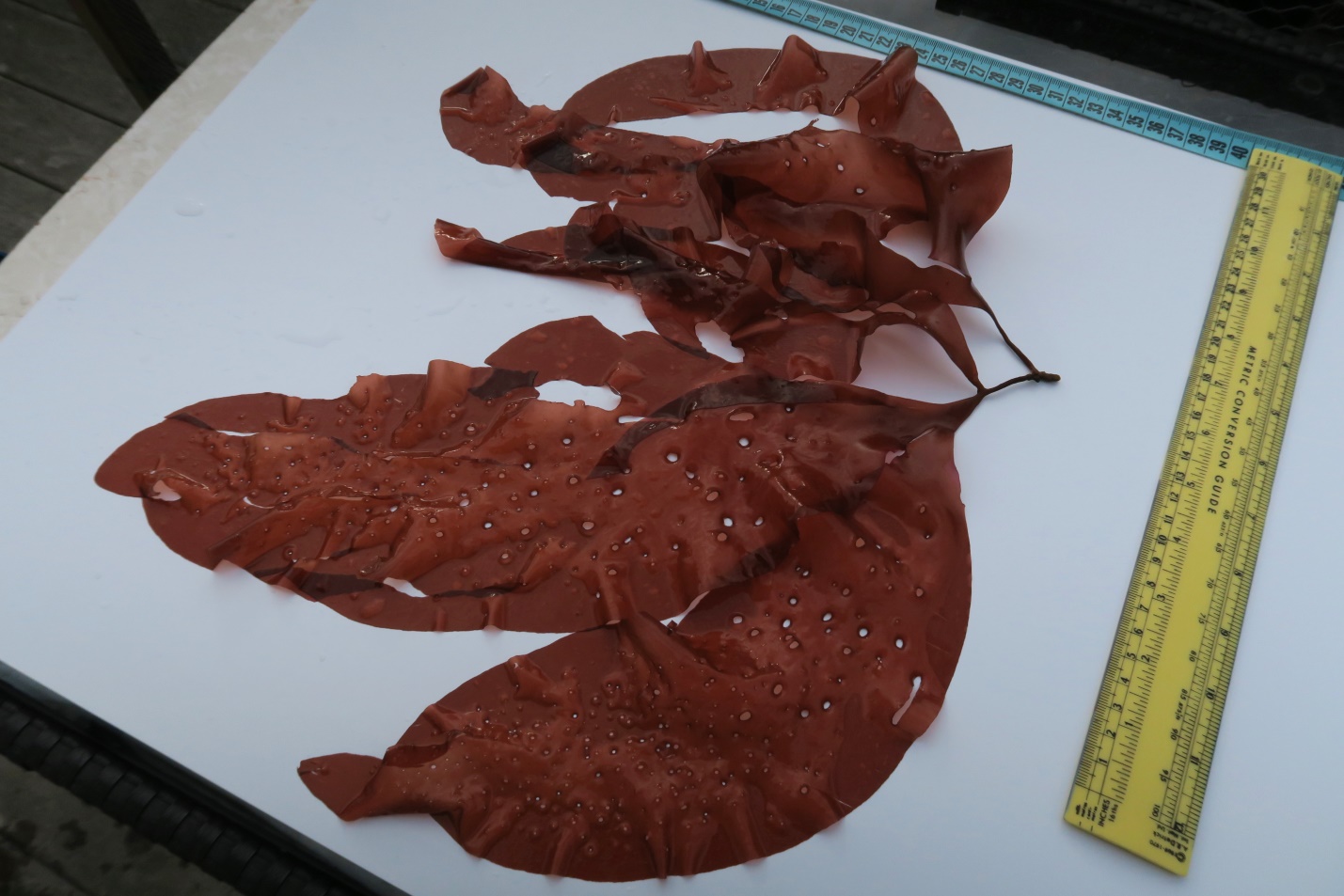
Sparlingia pertusa
Red Eyelet Silk
28 May 2021
Port San Juan, Juan de Fuca Strait, B.C., Canada.
Tide: 0.0 foot tide 09:23am PDT (measured at Port Renfrew Tidal station); -0.7 foot tide 10:18am PDT (measured at Sheringham Point Tidal Station)
Conditions: Wind, SW 20 – 30 km per hour, moderate southwesterly swell, overcast, no precipitation, 11˚C.
Phase of Moon: Waning Gibbous (approx. 54 hours into this phase at time of collection); (Previous Phase, Full Moon, 26 May 2021 at 4:13am PDT: Next Phase, Third Quarter, 2 June 2021 at 12:24am PDT.)

Figure 1: One entire mature blade of Sparlingia pertusa held up to the sky to better reveal the “eyelets” that distinguish this red alga; to the right a closer view shows the eyelets again plus numerous dark bumps which are reproductive cystocarps. Port San Juan and Mill Bay, Juan de Fuca Strait, B.C., Canada. May 27 & 28, 2021. Photo ID 27290 ©Seaweedwhisperings.com
Person 1:
Saw an alligator snout when I looked into the bucket (where we temporarily stored our collected seaweed samples) – startled me, I actually jerked my head back.
Exquisite – stunningly beautiful!
The puckers and holes in the blades, coupled with the simple blade shape add to the effect.
The beauty is distracting from getting to know it better.
We are looking at two blades; one has many cystocarps, the other has none. The one with none is more attractive – perhaps the beauty and innocence of youth.
To the touch it is much sharper than expected, like running my fingers along a rasp (or vegetable grater). I retreated from touching it.
Held a blade up – it twisted into a perfect helix spiral – I wonder if it has balanced energy?
The rose coloration is spectacular to my eye.
Something tells me, though, that it is having difficulty in manifesting its roles/goals in life. Perhaps it has actually lost that ability.
Casual, light interactions, not flirty.

Figure 2: On the left, two washed ashore blades of Red Eyelet Silk are laid out on a rock; on the right another blade reveals the crisp nature and wavy margins of this alga. Port San Juan and Mill Bay, Juan de Fuca Strait, B.C., Canada. May 27 & 28, 2021. Photo ID 29291 ©Seaweedwhisperings.com
Person 2:
Translucent pinkish-red, like a giant curved teardrop shape overall, tapers to a very fine point and expands out at the other end very fully and roundly.
Lovely graceful shape and softly wavy at margins.
Then all over the blade holes perforate the red smoothness.
The holes are rounded but not perfectly round – various rounded shapes.
Some holes seem perforated towards one side of the blade and some to the other side – there’s a kind of even randomness to it. This creates an edgy feel at the rims of the holes…
The holes have ‘sharper’ edges – not silky, crisper.
The blade with the cystocarps is much smaller, only 1/3 to ½ the size of the other.
The cystocarps make it an even more “dotted-looking” thing – holes are dots, and cystocarps are dots, too. Too many dots actually…
Held up blade by its base and it curls to form a spiral – very lovely.
I think this blade would waft ever gracefully in the water – like a dancing goddess dressed in finest silk and teasing and twisting and turning.
This seaweed feels its own beauty and unabashedly shares it.
Beautiful – it just is!
Unashamed, also not flaunting.
Whirling dervish (?) – whirls in certain conditions and then is torn away [we found entire blades of red eyelet silk washed ashore at many sites this past few days].
In water – red looks deeper; less deeply tinted out of water, there it’s a pink rose red.
The color is uniform throughout and is only interrupted by the holes and what flows through them or can be seen through them.
Smart design – holes make it not solid so the water doesn’t push / exert too strong a force, it just flows through the convenient holes and maybe encourages an interplay – twisting, spiraling, it’s playing with the water rather than reacting to its forces.
It can do what it wants – not what the water wants.
What aspect or part of yourself did you lose in all the holes, Sparlingia?
What is possible for you only because you have ‘lost’ whatever the holes once were?
Are you busy with that? Trying to know?
Deeper feeling – an inner depth; it doesn’t ask for any interaction with others but seeks a deeper interaction with self.

Figure 3: A winter storm dislodged this whole group of Sparlingia pertusa blades and washed it in with the tide. They are laid out for scale and were found in a relatively un-tattered state. Gonzales Beach, Juan de Fuca Strait, B.C., Canada. February 28, 2021. Photo ID 27292 ©Seaweedwhisperings.com
Biology & Natural History Information:
Description:
The obvious and numerous round holes that perforate the blade of this unique species make it easily identifiable in the field. However, these holes are often absent or less numerous in younger blades. The blade is undivided, somewhat crisp, bold red to rose-red in color, and tapers abruptly to a slender stipe that connects to a disc-shaped holdfast. As the seaweed ages, the color tends to bleach to a pale yellow, particularly at the upper margin. Blades grow up to about 60 cm in length and 20 cm in width. Cystocarps, occurring as small dark bumps on the blade surface, appear as the alga matures and becomes reproductive.
Habitat:
This annual red alga is common on rocky semi-exposed and exposed shorelines from the low intertidal zone to depths of at least 18 meters. Biologists studying it from the central coast of British Columbia have noted that it becomes less common as shorelines become more sheltered.
Distribution:
The range of Sparlingia pertusa extends from Korea and Japan to Russia, the Bering Sea and Aleutian Islands, Alaska, and down the coast of British Columbia and Washington to Oregon.
Former name(s): Porphyra pertusa, Rhodymenia pertusa, Rhodymenia stipitata
Classification:
Phylum: Rhodophyta
Class: Florideophyceae
Order: Rhodymeniales
Family: Rhodymeniaceae
Genus: Sparlingia
Species: Sparlingia pertusa (Postels & Ruprecht) G.W.Saunders, I.M.Strachan & Kraft 1999
![]()